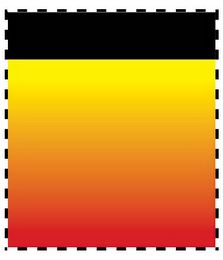Earlier this month, the Federal Circuit issued a precedential ruling on the question of whether a color mark for product packaging can ever be inherently distinctive, holding that the Trademark Trial and Appeal Board (TTAB) had erred in finding that (1) a color mark is incapable of being inherently distinctive, and (2) a color mark for packaging may only be inherently distinctive when defined by a peripheral shape or border.[1] The decision is important to brand owners looking to protect their marketing properties composed of color, and seemed to some an about-face from what was believed to be the holding in the Supreme Court’s decisions in Wal-Mart and Qualitex – that is, that a color mark can never be inherently distinctive, regardless of whether on a product or on the product’s packaging.
In the case at issue, Forney Industries, Inc. filed an application to register an ombre- or gradient-style mark composed of the colors red, orange, yellow, and black for welding-related and other goods. The drawing of the mark, shown below, was filed with a broken-line border, and the specimens submitted with application showed the mark on backing cards, hangers, and plastic packaging for various goods:
The USPTO Examining Attorney refused registration of the mark on the ground that it was not inherently distinctive, which Forney appealed to the TTAB. The TTAB, relying on its interpretation of prior Supreme Court decisions, agreed with the Examining Attorney and affirmed the refusal on the basis that Forney’s color mark for product packaging can never be inherently distinctive, and may be registered only with a showing of acquired distinctiveness. In a bit of a contradiction, the TTAB also found that there was no legal distinction between a mark consisting of a single color and marks consisting of multiple colors (such as Forney’s) without the addition of other elements, such as shapes or designs.
As mentioned, the Federal Circuit found that the TTAB had taken the holdings of prior Supreme Court cases too far, and agreed with Forney that color marks can be inherently distinctive when used on product packaging, depending upon the character of the color design, and that there is no requirement to associate a multi-color mark with a specific peripheral shape to be inherently distinctive.
This is good news for brand owners who use color as part of their brand language, but how can they use this decision to build additional protections around their marketing properties composed of color? First, the Federal Circuit’s decision makes it clear that whether packaging trade dress is a source indicator depends on several factors (the Seabrook factors) including, e.g., the “overall impression created by both the colors employed and the pattern created by those colors.” If you are considering registering the color(s) of your product packaging, or if you’re looking to develop a protectable color scheme for use on your product’s packaging, think about whether the colors of interest are atypical of the goods, versus in common use. If the latter (e.g., the color green for landscaping goods), consider adding another color, a novel pattern, or a fanciful effect (e.g., a reflective paper coating) to the mark, to enhance its inherent distinctiveness.
Forney’s holding of no requirement to associate a multi-color mark with a specific peripheral shape may also make it easier for brand owners to register their color marks for product packaging across their complete line of products, regardless of the product packaging’s silhouette. This may translate into broader coverage for the color mark, as well as fewer application filings.
And, thinking longer term, a registration for a color mark for product packaging could serve as the foundation for building rights in the same color mark for a product configuration, which requires a heightened showing of acquired distinctiveness or secondary meaning. Because exclusive use of a mark is a key factor in proving acquired distinctiveness, a registration for the same color mark for product packaging could keep competitors from biting at a brand’s color trade dress, in general, until sufficient exclusive use of the same color mark for product configuration can be shown.
Finally, and depending on the character of the color mark, the holding of Forney may make it easier for brand owners to claim rights in color marks for product packaging under common law, yet another tool in a brand owner’s arsenal of protection for its marketing properties.
[1] In re Forney Industries, Inc., No. 2019-1073, April 8, 2020. http://www.cafc.uscourts.gov/sites/default/files/opinions-orders/19-1073.Opinion.4-8-2020_1565957.pdf
This article appeared in the April 2020 issue of MarkIt to Market. To view our past issues, as well as other firm newsletters, please click here.

Receive insights from the most respected practitioners of IP law, straight to your inbox.
Subscribe for Updates
